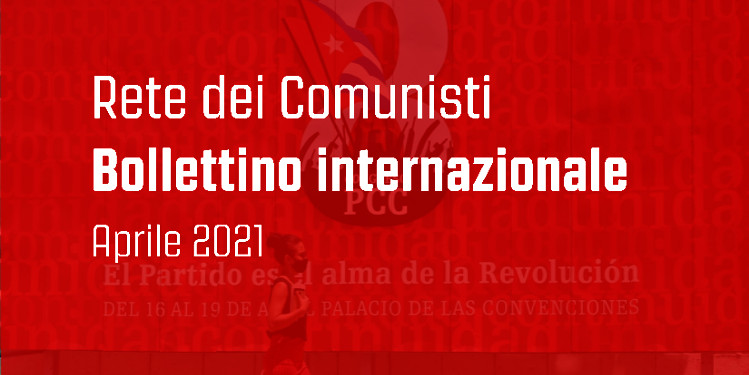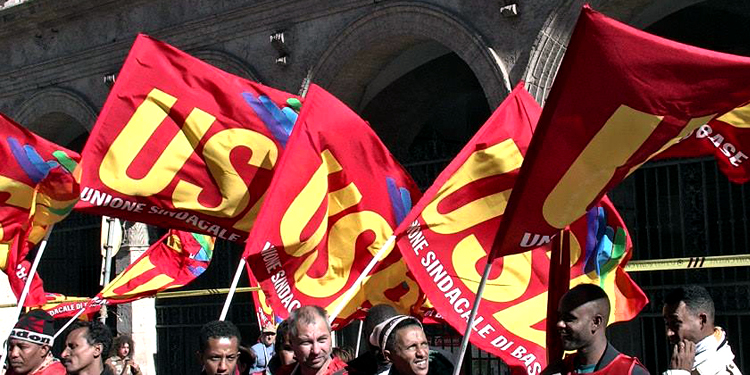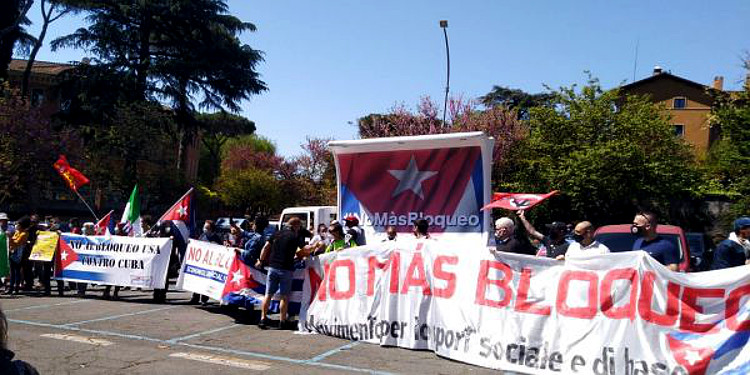| english | español | français | italiano
Rete dei Comunisti Roma
On March 13th, the Rete dei Comunisti of Rome organised the initiative “The condition of women at the time of the pandemic crisis: what ‘female emancipation’ from the virus of capitalist oppression?”.
For communists, at this stage, the need to provide an adequate response to the condition of exploitation of women, as well as the urgency of an ideological counterattack to the bourgeois model of women’s emancipation, is compelling.
Below is the opening speech of the initiative.
The Rete dei Comunisti of Rome organised today’s meeting on the question of the condition of women and women’s emancipation because of the now strong need to contextualise it and identify the issues around which as a communist organisation we must reflect and insist in our political action.
It is a theme that has been, and is being, addressed in different disciplines, psychoanalysis, sociology, economics, politics, etc., and from different points of view, such as that which
insists on the question of gender difference or that of equality and parity. The history of the feminist movement has always revolved around this dichotomy.
Today we are interested in – and we choose – to start from the material datum within the current context, which is that of the pandemic within the systemic crisis and the ongoing competition between imperialist poles, where precisely the Covid crisis is on the one hand the product of that crisis and on the other the opportunity for a change of phase
So let us start with the data, which is what struck us in recent weeks, when ISTAT published the numbers of jobs lost in December 2020, which involved, out of 101,000 workers, as many as 99,000 women, so practically 99% of the new unemployed. Compared to December 2019 there are also 444,000 fewer workers, of which 312,000 are women. Thus, in the year of Covid, the overwhelming majority of those who lost their jobs are women, i.e. the exploited, precarious workforce with no contractual guarantees and whose access to or removal from the world of work has always been linked to the needs of capital.
History provides us with many examples of how the female workforce has always functioned as a surplus value within the capitalist mode of production. As early as the beginning of the 20th century, documents can be found showing how female labour was sometimes preferred to male labour because it was cheaper and less guaranteed by law. It was clear even then how the capitalist system has pivoted and continues to pivot on the question of ‘economic blackmail’.
Let us consider the role of women during the wars: with the male population being called up for military duties, the needs of factories and offices required an increase in the number of women in the workforce, who received lower wages than the men whose place the new workforce had taken. In the factories they were employed as general labourers, but this replacement was temporary and linked to the years of conflict. In the clerical and service sectors, women were also employed on a massive scale, but again on a temporary basis. At the end of the conflict, a large part of the female workforce was laid off and women were encouraged by the State to help repopulate the country.
In the intertwining of the productive and reproductive functions within society, the role of women was the result of constructions structured around the socio-economic needs of the system: in periods of crisis women have greater difficulty entering and easier exit from the world of work, just as in moments of economic growth there is an advancement in the living and working conditions of women and other exploited categories. Taking up Fourier’s statement, later quoted by Marx in “The Holy Family”, that the level of civilisation of a society is measured by the condition of women, we can speculatively state that the index of exploitation of women becomes the measure of the exploitation of all the most precarious categories.
As Carla Filosa writes, women have been reduced […] to a historical function of capitalist relations: trained to mediate consensus between generations for the temporal continuity of these relations, they are also adaptable to enter and leave the labour market – where they are mostly relegated to the lowest income levels – in order to constitute a perennially usable wild card for social savings, without any signs of organised rebellion against the command of capital.
Since the 1970s there has been a steady increase in the female workforce in industrialised countries, as more schooling has enabled them to enter the business and service sectors. Today, faced with a crisis that is not only pandemic but more generally systemic, capitalism is trying to find a way out by proposing a restructuring of the current production model, focusing on specific sectors such as the so-called green economy or digitalisation. With the EU’s de facto commissioning of Italy through the imposition of Draghi at the head of the government, we are encountering this profound restructuring of the economic apparatus for the benefit of the interests of big business and profit, which obviously cannot be reconciled with the interests of the working classes.
So in what direction can the Next Generation EU plan point when it dedicates an entire section to the theme of inclusion and cohesion (within which, among other things, the condition of women and the condition of young people are united), with particular attention to what is defined with the scenographic term of “female empowerment”? In the direction of reiterating the policies of exploitation of what we could define as a reserve industrial army, in its broadest sense of a weapon in the hands of the capitalists (as Marx defined it in Capital), through the precariousness, the blackmailing of women in the subordinate groups and through policies of support, on the contrary, to that female entrepreneurship compatible with the objectives of the present state of affairs that does not exclude, indeed favours, the possibility for that component to reach positions of leadership.
Today there are women who have reached high levels of responsibility, public figures with authoritative roles within the system, those that Elisabetta Teghil calls ‘the patriarchs’, whose successes pass for examples of female emancipation within the bourgeois narrative flattened on belonging to gender rather than class. The tools in the hands of the bourgeoisie in this case are represented by recourse to transversal themes such as gender violence, or the question of civil rights for example, which in the history of the reformist strand of the women’s movement has led to the victory of important battles, such as education, the right to vote, and divorce. These are all important struggles which, however, focus mainly on issues of equality and equity, and do not contemplate the hypothesis of ‘isolating’ the class question.
The issue of sexist violence is also certainly transversal, but it has a greater incidence within the exploited groups, because it is on them that the effects of economic blackmail fall, and because in society, therefore in the workplace and in many cases in the family, the patriarchal model and domination is also culturally internalised and re-proposed. In the family, the man is the bourgeois and the woman represents the proletarian, wrote Engels. It is violence that is established – Pierre Bourdieu states – when the schemes he [the dominated] employs to perceive and evaluate himself or to perceive and evaluate the dominant […] are the product of the incorporation of the classifications, thus naturalised, of which his social being is the product. In the section of the Statistical Yearbook of the Municipality of Rome dedicated to social issues, the graphs make immediately visible how most of the women who turned to the Anti-Violence Centres in the last year came from the peripheral areas of our city.
This flattening on gender specificity, which inspires the mainstream policies (but also, albeit with different intentions and different objectives, the platforms of women’s movements in the West in recent years, such as Me Too), is all the more insidious when it insists on the difference between two different ‘natures’, the female one, the feminine nature, weaker, more inclined to care work and taking care of the family and children, or to work in less qualified and lower paid sectors, and the masculine nature, strong, dominant, active, projected outwards, into the world of work and profession where men can enjoy greater life and career opportunities.
As the French sociologist Colette Guillaumin wrote in 1977, a social relationship, here a relationship of domination, of force, of exploitation (such as the one between man and woman or between whites and blacks), the one that secretes the idea of nature, is considered as the product of the internal traits of the object that undergoes the relationship, traits that would be expressed and unfold in specific practices (such as the care activities for women or, using Guillaumin’s example, “cleaning shit”). In Guillaumin’s words, the specific nature of the social group that undergoes the relationship of domination is thus traced. In this way the idea of a natural group is invented: of “race”, of “sex”, which inverts the reasoning.
Therefore, we can see how the roles attributed to the different social components are the result of constructions structured on the socio-economic needs of the system. What is more, in many cases power appropriates the key words of historical feminism in order to use them for the purposes of pacification
The power tends to replicate in the media representation the figure of the woman as the passive victim, who eventually needs to delegate to other subjects the resolution of their demands. But to ask for more rights, or more equality, to a system that has subsumed the secular patriarchy to manage the exploitation from which it is fed is at this point not only useless for a real emancipation, but functional to social control. The OSA comrades have done well in recent days, in the video released on the occasion of the harassment suffered by one of them, to say “we will not be victims, but revolutionaries”, which is the refusal not only of an objective condition but is the refusal to wear a dress deliberately sewn on the female figure.
The fact that the victimisation of women is the stereotype through which the perfect network woven between patriarchy and the capitalist system harnesses the self-determination of exploited women is demonstrated once again by history: think of the Resistance, during which 70,000 women were organised in Women’s Defence Groups, committed precisely to supporting the Resistance, 35,000 worked as fighters and many also took on leadership roles, not delegating the monopoly of violence to men. This is demonstrated by the movements around the world that have seen and see an important role of women in the struggles for liberation: coming to the present day we think of the Kurdish women who, with the Units for the Defence of Women in Rojava or with the PKK have freed from Isis thousands of square kilometres in northern Syria. In their appeal for 8 March this year, the Kurdish women fighters themselves said they were inspired by the resistance of women “from Sudan to Palestine, from Latin America to Asia, against fascism, sexism and nationalism”. Or think of the Zapatista fighters who last year, again on 8 March, refused to take part in the international women’s meeting because they had to carry on, weapons in hand, their struggle following the election of Obrador in Mexico, and then launched an appeal: ‘we know that capitalism is everywhere and we women must not stop fighting so that no one in any corner of the world is afraid to be a woman’.
To conclude, we return to our initial question: what response are we as communists called upon to provide with regard to the exploitative condition of women? That of framing it within the condition of exploitation of the class and that of structuring the ideological counter-attack to the response of the bourgeoisie using Marxist analysis as an instrument of struggle. Because only through the struggle against the capitalist system within a strategic and organised project of revolutionary rupture can real emancipation be achieved. The struggle for women’s emancipation necessarily passes through the struggle against this system, just as all of us, when we take to the streets in the many moments of struggle that engage us politically, we do so bearing in mind that a revolutionary process cannot disregard the issue of women’s emancipation from the exploitation perpetrated, including through patriarchy and the bourgeois ideological offensive, by this system.
Link to the video of the entire initiative (facebook): https://www.facebook.com/watch/live/?ref=watch_permalink&v=743472733031286






